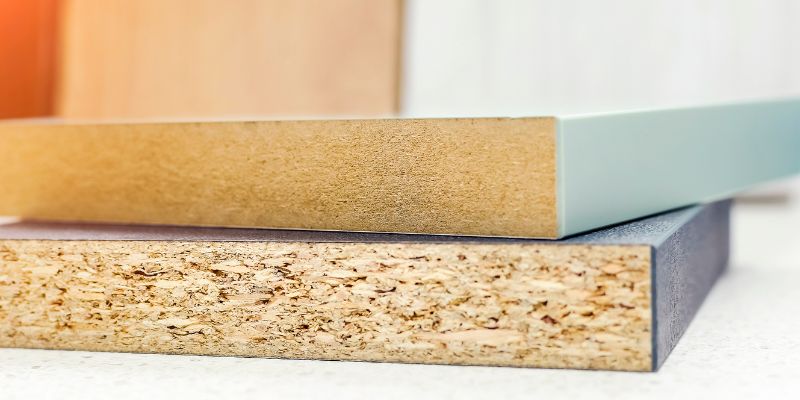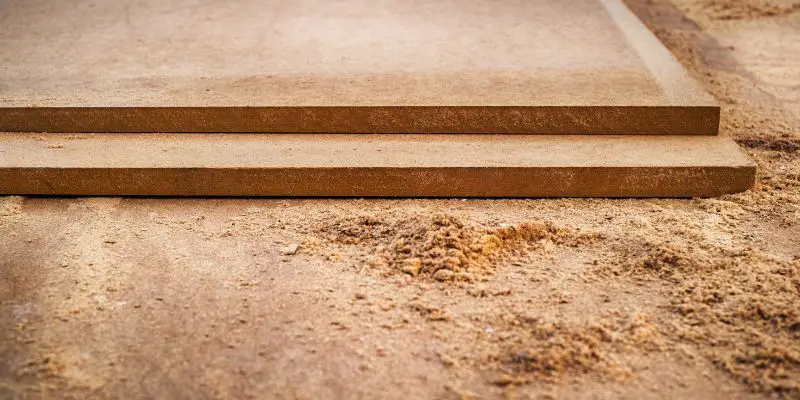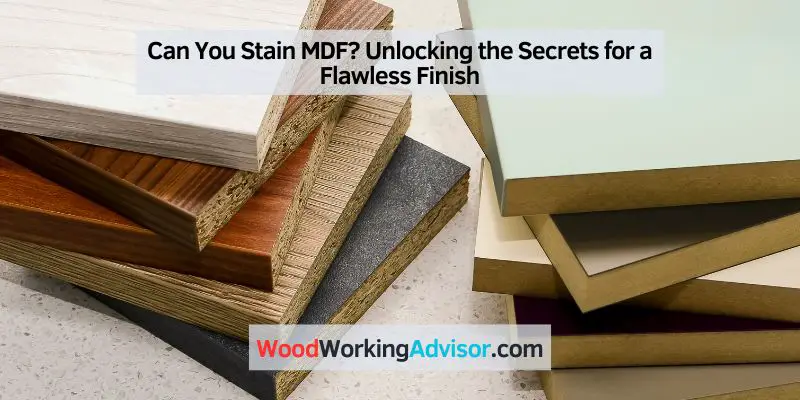Yes, you can stain MDF to achieve the desired color and finish. MDF, or medium-density fiberboard, is a versatile and affordable wood alternative often used in cabinetry and furniture.
Its smooth surface allows for even staining, but it requires proper preparation and techniques for best results. By following the recommended steps, including sanding, priming, and using the appropriate type of stain, you can successfully stain MDF to enhance its appearance and match your desired aesthetic.
Whether you prefer a natural wood look or a bold, modern finish, staining MDF offers a range of options to suit your project.
Preparing Mdf For Staining
Before you can achieve a beautiful stained finish on your Medium Density Fiberboard (MDF) projects, it’s important to properly prepare the surface. Taking the time to clean, sand, fill, and seal the MDF will ensure that the stain goes on smoothly and evenly, resulting in a professional-looking outcome. In this section, we will discuss each step in detail to help you achieve the best possible results.
Cleaning And Sanding The Surface
To start the preparation process, it’s crucial to clean the MDF surface thoroughly. Dust, dirt, and any existing finish residue can affect the stain’s adherence, leading to an uneven finish. Use a clean, lint-free cloth or a soft brush to remove any debris.
Next, sanding the MDF is an essential step. Not only does it remove imperfections and smooth out the surface, but it also opens up the pores of the MDF, allowing for better stain absorption. Using a fine-grit sandpaper, gently sand the entire surface, paying close attention to any rough areas or edges.

Cleaning and Sanding the Surface
To start the preparation process, it’s crucial to clean the MDF surface thoroughly. Dust, dirt, and any existing finish residue can affect the stain’s adherence, leading to an uneven finish. Use a clean, lint-free cloth or a soft brush to remove any debris.
Next, sanding the MDF is an essential step. Not only does it remove imperfections and smooth out the surface, but it also opens up the pores of the MDF, allowing for better stain absorption. Using a fine-grit sandpaper, gently sand the entire surface, paying close attention to any rough areas or edges
Filling And Sealing Mdf
While MDF is a versatile material, it has a tendency to absorb stains unevenly due to its porous nature. Therefore, filling and sealing the MDF before staining is crucial to achieving a smooth and even finish. Start by applying a wood filler to any visible defects, such as cracks, dents, or holes. Allow the filler to dry completely, and then sand it down until it’s flush with the surface.
Once the surface is smooth and free of imperfections, it’s time to seal the MDF. Applying a high-quality wood sealer or primer will help prevent the stain from soaking into the MDF too quickly, ensuring an even color distribution. Use a foam brush or a paint sprayer to apply a thin, even coat of sealer or primer, following the manufacturer’s instructions.
Filling and Sealing MDF
While MDF is a versatile material, it has a tendency to absorb stains unevenly due to its porous nature. Therefore, filling and sealing the MDF before staining is crucial to achieving a smooth and even finish. Start by applying a wood filler to any visible defects, such as cracks, dents, or holes. Allow the filler to dry completely, and then sand it down until it’s flush with the surface.
Once the surface is smooth and free of imperfections, it’s time to seal the MDF. Applying a high-quality wood sealer or primer will help prevent the stain from soaking into the MDF too quickly, ensuring an even color distribution. Use a foam brush or a paint sprayer to apply a thin, even coat of sealer or primer, following the manufacturer’s instructions.
Choosing The Right Stain
Choosing the right stain is crucial in achieving the desired effect and enhancing the natural beauty of the MDF. There are various types of wood stains available, such as oil-based stains, water-based stains, and gel stains. Consider factors such as color, sheen, and compatibility with the MDF before making a decision.
It’s advisable to test the stain on a small inconspicuous area of the MDF or on a scrap piece to ensure it provides the desired results before applying it to the entire surface. Additionally, follow the stain manufacturer’s instructions regarding the application and drying time for the best outcome.
Choosing the Right Stain
Choosing the right stain is crucial in achieving the desired effect and enhancing the natural beauty of the MDF. There are various types of wood stains available, such as oil-based stains, water-based stains, and gel stains. Consider factors such as color, sheen, and compatibility with the MDF before making a decision.
It’s advisable to test the stain on a small inconspicuous area of the MDF or on a scrap piece to ensure it provides the desired results before applying it to the entire surface. Additionally, follow the stain manufacturer’s instructions regarding the application and drying time for the best outcome.
Techniques For Staining Mdf
Staining Medium Density Fiberboard (MDF) can be a great way to enhance the appearance of your furniture or wooden crafts. MDF is a versatile and cost-effective material that takes stain well, but it does require some specific techniques to achieve the best results. In this article, we will explore the key techniques for staining MDF, including applying the stain, avoiding common mistakes, and achieving a professional finish.
Applying The Stain
When it comes to staining MDF, applying the stain properly is crucial for achieving an even and attractive finish. Follow these steps to ensure your stain is applied correctly:
- Prepare the MDF: Before applying the stain, make sure the MDF surface is properly sanded and free from any dust or debris. Use a fine-grit sandpaper to smooth out the surface and create a clean canvas for the stain.
- Choose the right stain: MDF tends to absorb stain differently compared to natural wood, so it’s important to choose a stain that’s suitable for MDF. Water-based stains are often recommended for their easy application and quick drying time. However, oil-based or gel stains can also provide excellent results.
- Apply a pre-stain conditioner: MDF has a tendency to absorb stain unevenly, resulting in blotchy or inconsistent coloration. To prevent this, it’s recommended to apply a pre-stain conditioner to the MDF before staining. This conditioner helps the stain penetrate more evenly, resulting in a more uniform appearance.
- Apply the stain: Use a brush, cloth, or sponge to apply the stain evenly across the MDF surface. Follow the manufacturer’s instructions regarding the application time and number of coats. Start with a light coat and gradually build up the color if desired. Make sure to work in small sections to ensure that the stain doesn’t dry too quickly before you can even it out.
- Wipe off excess stain: After applying the stain, allow it to penetrate the MDF for the recommended duration. Then, use a clean cloth to wipe off any excess stain. This will help to prevent pooling and ensure a more professional and polished finish.
Avoiding Common Mistakes
While staining MDF can be a straightforward process, there are a few common mistakes to avoid to achieve the best results:
- Skipping the sanding step: Neglecting to properly sand the MDF can result in an uneven and blotchy stain application. Take the time to prepare the surface before staining for a smoother finish.
- Not using a pre-stain conditioner: As mentioned earlier, MDF tends to absorb stain unevenly. Using a pre-stain conditioner can help prevent this issue, resulting in a more consistent color and finish.
- Applying too much stain: It’s important to apply the stain in thin, even coats, allowing the MDF to absorb the color gradually. Applying too much stain at once can lead to pooling, streaks, and an uneven finish.
- Rushing the drying process: Make sure to allow the stain to dry completely between coats. Rushing the drying process can interfere with the absorption and adhesion of subsequent layers, resulting in an inferior finish.
Achieving A Professional Finish
To achieve a professional-looking finish when staining MDF, consider the following tips:
- Seal the stained MDF: Once the stain has dried, apply a clear sealant or varnish to protect the stained surface and enhance its durability. This step will also add a glossy or satin sheen to the finish, depending on your preference.
- Lightly sand between coats: If you’re applying multiple coats of stain, lightly sanding the surface between coats can help create a smoother and more seamless finish.
- Use a high-quality brush or applicator: Investing in a high-quality brush or applicator can make a significant difference in the final result. A good brush will help control the stain application and ensure a more even and professional finish.
By following these techniques for staining MDF and paying attention to detail, you can achieve stunning results and transform your MDF projects into beautiful pieces of furniture or artwork.
Tips For Maintaining Stained Mdf
Stained MDF (Medium Density Fiberboard) can add a touch of elegance and warmth to any space. But to ensure its longevity and keep it looking its best, proper maintenance is key. In this section, we’ll explore some essential tips for maintaining stained MDF.
Regular Dusting And Cleaning
Dusting is the first line of defense when it comes to keeping your stained MDF looking fresh and vibrant. Regular dusting helps remove dirt, dust, and other particles that can accumulate over time, enhancing the longevity of the stain finish.
A soft microfiber cloth or a feather duster can be used to gently wipe the surface. Avoid using abrasive materials or harsh chemicals as they may damage the stain and the MDF board itself. For hard-to-reach areas, using a soft-bristled brush can help get rid of dust effectively.
When it comes to cleaning stained MDF, always opt for gentle and mild solutions. Avoid excessive moisture, such as soaking the surface with water, as MDF is susceptible to swelling and warping when exposed to liquids for extended periods. Instead, lightly dampen a cloth with a mixture of water and a mild detergent, and gently wipe the stained surface. Immediately dry with a separate cloth to prevent any moisture from penetrating the wood fibers.
Protecting Against Moisture
Moisture is one of the most significant threats to stained MDF. Protecting against moisture is essential for maintaining the quality and appearance of the stained finish.
To prevent moisture damage, it’s crucial to avoid placing stained MDF in areas with high humidity, such as bathrooms or kitchens. Additionally, ensure that any spills or water splashes are promptly wiped clean to prevent moisture from seeping into the fibers of the MDF board.
Applying a protective sealant or top coat can be an effective way to enhance the moisture resistance of stained MDF. This additional layer can act as a barrier, preventing water from directly contacting the wood fibers. Before applying any sealant or top coat, check the manufacturer’s instructions to ensure compatibility with the specific stain used on your MDF.

Repairing Scratches And Damage
Despite our best efforts, scratches or damage can occasionally occur on stained MDF. Taking immediate action to repair the surface can help maintain the overall appearance.
For minor scratches, you can try using a color-matching wood filler or marker specifically designed for MDF. Fill in the scratch and blend it with the surrounding stained surface. Remember to follow the manufacturer’s instructions carefully for the best results.
If the damage is more severe, a refinishing process may be necessary. This involves sanding down the entire stained surface, removing the existing stain and finish, and applying a new stain and protective top coat layer. It’s recommended to consult a professional or follow detailed guides for refinishing stained MDF.
By diligently following these tips for maintaining stained MDF, you can enjoy the beauty and durability of this versatile material for years to come.
Frequently Asked Questions On Can You Stain Mdf
What Can I Use To Stain Mdf?
To stain MDF, you can use a wood stain specifically designed for MDF. Apply the stain evenly with a brush or cloth, following the wood grain. Allow it to dry completely before applying a protective finish, such as polyurethane or varnish.
Can You Make Mdf Look Like Wood?
Yes, you can make MDF look like wood. By using techniques like staining, painting, or applying a wood veneer, you can achieve a realistic wood appearance on MDF surfaces.
How Do You Change The Color Of Mdf Wood?
To change the color of MDF wood, you can use paint or a wood stain. Apply a primer before painting and sand the surface for even results. For staining, use a brush or cloth and apply multiple coats for desired color intensity.
Can You Stain Or Paint Mdf Board?
Yes, you can stain or paint MDF board. It is important to prepare the surface by sanding it, then applying a primer before painting or staining. This will help the paint or stain adhere properly and provide a smooth finish.
Conclusion
Staining MDF is a possible option to achieve a desired look for your furniture or projects. By following the right steps, such as sealing the edges and sanding it properly, you can successfully stain MDF to your liking. Remember to choose the right type of stain and test it on a small area before applying it to the entire surface.
With care and patience, you can transform MDF into a beautifully stained piece that fits your aesthetic preferences.


